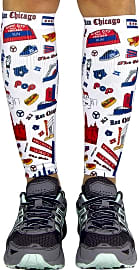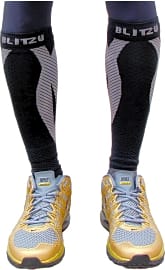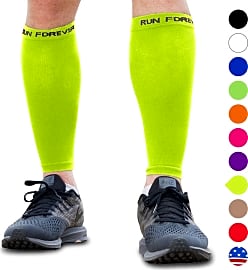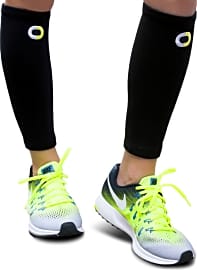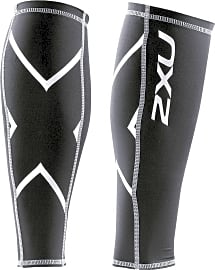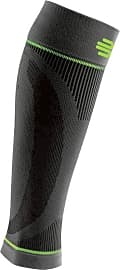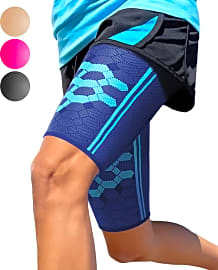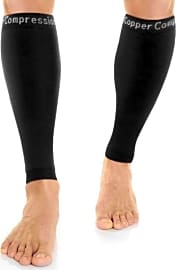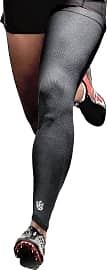The 10 Best Compression Sleeves

This wiki has been updated 37 times since it was first published in September of 2015. Using compression, these leg sleeves help warm up muscles more quickly, relieve pain caused by stiffness and soreness, and potentially diminish recovery time after an injury. They're great for before, during, and after workouts, and can even help prevent deep vein thrombosis in the legs and reduce swelling, making them ideal for people of all ages and athletic capabilities. When users buy our independently chosen editorial selections, we may earn commissions to help fund the Wiki.
Editor's Notes
June 09, 2021:
No changes were made to the Wiki this time around. We still highly recommend the Doc Miller Premium because of their specific graduated tension, while the Zensah Leg is still a great choice for something with fun designs. As always, make sure not to get a pair that's too tight for you, as that can cause multiple issues. Alternatively, compression sleeves and compression socks can be useful in preventing deep vein thrombosis on long flights.
April 01, 2020:
Many athletes swear by compression gear, and we've kept plenty of options here for everyone from runners to bicyclists. Note, though, that compression sleeves should be used with care; when the elastic is too tight or when they're used by people with skin infections, peripheral neuropathy, or pulmonary edema, they can potentially do more harm than good. If you have preexisting conditions, you should talk to your doctor or physical therapist before you add compression sleeves to your workout or recovery gear.
With that said, we've removed the BeVisible Sports Support over concerns that their sizing runs a touch too small, leading too easily to discomfort. The Tuff Togs Seriously Tight and the Endurance Shield 360 Shin Splints have become hard to find, so we've removed them, as well. But when it comes to effective compression you can count on, we still like the Zensah Leg, and we've selected the Doc Miller Premium as a contender, as well. Both come in a huge range of fun and fashionable colors and patterns, and both offer several sizes to accommodate a range of users. The latter is also available in a longer model that partially covers the foot, providing more coverage area.
For those who are concerned about the muscles in the thigh, we've added the Sparthos Thigh and the Vital Salveo Germanium. The former covers the area above the knee, while the latter supports the whole leg, but both give you the compression you need in the upper leg. When combined with a quality foam roller, this gear should offer excellent full-leg recovery to runners, hikers, and more.
Special Honors
Incrediwear Leg Sleeves You can go a long way toward reducing swelling with the Incrediwear Leg Sleeves, a simple but effective option that was created to help speed post-operation recovery. Their blend of polyester, nylon, and spandex allows them to breathe and ensures that they're easy to both wash and dry, too. incrediwear.com
Science Behind Compression Sleeves
Muscle fatigue is another factor contributing to decreased performance.
In order to understand why compression sleeves are effective, one must first have a basic understanding of how blood flows throughout the body. The heart pumps oxygenated blood to the muscles and extremities via the arteries. Cells inside of the muscles use up the oxygen and other nutrients in the blood. Once the blood is depleted of its beneficial elements, it gets sent back to the heart, along with lactic acid and other waste through the veins. The heart replenishes the blood, starting the cycle again.
Providing the muscles with oxygenated blood during exercise is vital to performance. The more oxygen cells receive, the better they function. The more blood that flows into and out of a muscle, the more lactic acid and other waste will be carried away. Muscle fatigue is another factor contributing to decreased performance. Providing muscles with a steady supply of oxygenated blood allows them to perform longer before becoming fatigued.
Compression sleeves are designed to provide graduated compression from the extremity to the body. This means they are tighter at the wrists or ankles and gradually get looser as they move further up the arm or leg. Graduated compression can help fight the effects of gravity, assisting in venous return. Consistent compression causes the arterial walls to dilate, which increases the amount of blood that flows through them. Some studies state that graduated compression can increase arterial blood flow by up to 40 percent during activity, and up to 30 percent during recovery.
More blood flow equates to more oxygen and more nutrients delivered to muscles. In addition to increasing blood flow, compression sleeves constrict the veins, increasing the velocity of the blood flowing through them. This helps deoxygenated blood get back to the heart quicker. Since this depleted blood is also carrying waste and lactic acid out of the muscles, it reduces muscle soreness and recovery time.
Measuring Yourself For Compression Sleeves
Proper sizing is vital to the effectiveness of compression sleeves. If they are too loose, they won't do their intended job, and if the they are too tight, they may constrict blood flow having a negative effect on performance instead of a positive one. Before purchasing any compression sleeves, measure you legs to ensure you buy the right size.
Ideally you should choose a sleeve that uses the most measurements possible for the best fit.
If you are buying compression sleeves for the lower legs, those which run from the ankle to the upper calf, you will need to take three measurements. First measure the circumference of your ankle. To do this, take a tape measure and wrap it around the narrowest part of your ankle. This should be about an inch of less above the top of the ankle bone. Next measure the circumference of your calf at the thickest part. The last measurement needed is the calf length.
To get an accurate calf length measurement, sit in a chair with your leg bent at a 90 degree angle. Measure the distance from a half an inch under the bend of your knee to the floor. Having these three measurements will give you the best chance of choosing the correct sized calf compression sleeve.
Not all companies will use all three of these measurements. Some may only indicate calf height and calf circumference, while others may use calf circumference and your total height to help you choose the size. Ideally you should choose a sleeve that uses the most measurements possible for the best fit.
For knee compression sleeves, you will need to take different measurements. Thigh circumference should be measured 5 inches above the center of the knee. Calf circumference should be taken five inches below the center of the knee. These two measurements will dictate the size of the knee sleeve which is best for you.
The Importance Of Recovery Time
This may seem counter intuitive to some, but taking time to rest and allow your body to recover is one of the most important factors contributing to muscle growth. No matter how hard you workout, you won't see maximum muscle growth unless you allow your body to rest and recuperate between sessions. Over training and training fatigued muscles is actually one of the foremost causes of injury during exercise. Some indications that you may be over training include muscle tightness, depression, decreased motivation, general feelings of malaise.
No matter how hard you workout, you won't see maximum muscle growth unless you allow your body to rest and recuperate between sessions.
Muscle fibers are torn during strenuous workouts, which is one of the reasons people feel sore. Recovery periods allow your body to adapt to the stress of exercise, and repair and rebuild torn muscle fibers. It also gives the body a chance to replenish energy reserves, so you can workout intensely at the next gym session. Since your body is actively repairing and replenishing itself during recovery, it should be thought of as a positive step in muscle growth.
Everybody requires a different amount of recovery time, and the key is listening to your body. If your body is still sore from a previous workout, it is best to let those muscles recuperate before hitting them again. Instead of going back to the gym and working on the same muscle groups, focus on ones that are not sore.
Getting a minimum of eight hours or restful sleep, feeding your body healthy foods and an adequate amount of protein, wearing compression sleeves during and after a workout, and staying well hydrated are four steps which will help your body recover as quickly as possible.


